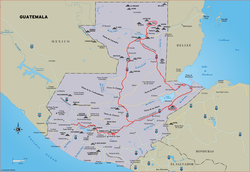
We embarked on our long excursion quite a while ago (I'm not telling you exactly when or you'll make fun of me). This was an 11 day trip around Guatemala for ostensibly "academic" purposes, okay there was some academics, but it was mostly just experiencing Guatemala in its many forms. The map to the left illustrates our path around Guate. Even though the entire country is actually smaller than Minnesota, it takes about four of five times as long to get anywhere here because of all the mountains, not to mention the sometimes superfluous amount of speed bumps. So, remember that this map includes at least two 8 hour drives, as well as several 4-5 hour drives in between.
We started out our trip from Xela and spent the first night in Guatemala City. There we met with two different organizations, one was a human rights group that has been working for many years, even during the armed conflict, to recover knowledge about los desaparecidos. Los desaparecidos are the people who were "disappeared," and typically they remain missing or were later found dead. The second group we met with was a worker's rights group, this one was particularly interesting, given the almost complete ban on worker's rights organizations during the armed conflict. They had quite the leftist lean to them, to say the least.
We started out our trip from Xela and spent the first night in Guatemala City. There we met with two different organizations, one was a human rights group that has been working for many years, even during the armed conflict, to recover knowledge about los desaparecidos. Los desaparecidos are the people who were "disappeared," and typically they remain missing or were later found dead. The second group we met with was a worker's rights group, this one was particularly interesting, given the almost complete ban on worker's rights organizations during the armed conflict. They had quite the leftist lean to them, to say the least.
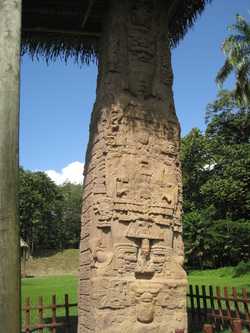
The second day was mostly driving, but we stopped off to take in some quaint ancient Mayan ruins in Quiriguá. These ruins are quite different than most people think of when they think Mayan ruins. First of all, there are no huge temples, as Quiriguá wasn't so much a large city as it was more of a conjunction for trade-routes and a point of transit between the intermediate indigenous population in Copán (in Honduras) and the Maya located in what is now Guatemala. The principle trade route for jade went through Quiriguá, at one point in time, so it was moderately important in the Mayan society of its time.The architecture of Quiriguá is not actually all that much to speak of, however, the monuments are quite impressive. The monuments, called stela, are all quite intricately carved. The stela in the picture is also the one of the largest monumental sculpture erected in the New World. In fact, at one point in time it had fallen over, probably due to a lot of rain and possibly earthquakes. The statue was unbroken, but when they tried to raise it with a winch and cables, it broke. So, in my mind, that leaves the question, how did the Mayas do it? I'll be pondering that one for a while.

At some point in time the, United Fruit Company (see the root of all fruit evil) had acquired the land around Quiriguá, and so literally all of the surrounding land was turned into banana plantation. For some eye opening reads about the origin of your fruit as well as U.S. influence in other countries, I'd recommend The Fish That Ate the Whale, and Bitter Fruit.
After a while of driving through miles and miles of banana trees, we began to see semi-truck after semi marked with Dole, Chiquita, and Del Monte, United Fruit company might not be its name anymore, but it's still going strong in Central America. Shortly thereafter we arrived in Puerto Barrios, the port that was essentially built so that the fruit companies could export, mostly to the U.S.. It was quite impressive to see all of the shipping containers packed sometimes four or five high marked with Dole and the other companies. The world certainly has a banana addiction.
Our hotel that night was none other than the Hotel del Norte, the hotel from where the banana barons had reigned during the heydays of the Banana Republics. The hotel is made out of wood, which is actually quite rare in Guate, and it's easy to see why. Most of the floors had at least some slant to them, if not some extreme slants. Nevertheless, it was actually quite easy to imagine the banana barons and their families holding sway in that once (somewhat) stately place.
After a while of driving through miles and miles of banana trees, we began to see semi-truck after semi marked with Dole, Chiquita, and Del Monte, United Fruit company might not be its name anymore, but it's still going strong in Central America. Shortly thereafter we arrived in Puerto Barrios, the port that was essentially built so that the fruit companies could export, mostly to the U.S.. It was quite impressive to see all of the shipping containers packed sometimes four or five high marked with Dole and the other companies. The world certainly has a banana addiction.
Our hotel that night was none other than the Hotel del Norte, the hotel from where the banana barons had reigned during the heydays of the Banana Republics. The hotel is made out of wood, which is actually quite rare in Guate, and it's easy to see why. Most of the floors had at least some slant to them, if not some extreme slants. Nevertheless, it was actually quite easy to imagine the banana barons and their families holding sway in that once (somewhat) stately place.
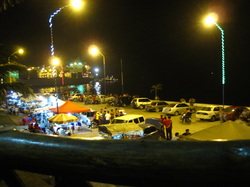
While the hotel itself was interesting, what got my attention was what was happening right outside, honestly, it was hard not to notice it with all of the music emanating from every trunk of every car parked out there. This is the malecón or seawall of Puerto Barrios and everything about it reminded me of the descriptions I've heard and read about THE Malecón in Havana, Cuba. That is to say, it is THE nighttime hang out for young Puerto Barrianos. I certainly enjoyed watching, and sometimes dancing with, the lively night life from up on the hotel balcony! With all of the merengue, salsa, and bachata ringing out, I was feeling quite like I'd arrived in a tropical dream. I have to admit to falling in love with the Caribbean coast of Guate right then and there. If, in the future, you find me on some Spanish speaking Caribbean island, this is where that particular love affair started.
The next day, we found ourselves tramping around a rain forest/preserve area, which was quite fun. I particularly enjoyed sitting next to some of the waterfalls and writing in my journal. After that, we went back to Puerto Barrios to catch a "ferry" over to Livingston, which can only be reached by boat. This is how I know that I'm a lake girl, the boat ride, on the open ocean, was easily one of the highlights of this trip. I swear, I didn't stop grinning the whole ride. Below is one of the videos I took from the lancha, you can get a bit of an idea of how bumpy it was.
The next day, we found ourselves tramping around a rain forest/preserve area, which was quite fun. I particularly enjoyed sitting next to some of the waterfalls and writing in my journal. After that, we went back to Puerto Barrios to catch a "ferry" over to Livingston, which can only be reached by boat. This is how I know that I'm a lake girl, the boat ride, on the open ocean, was easily one of the highlights of this trip. I swear, I didn't stop grinning the whole ride. Below is one of the videos I took from the lancha, you can get a bit of an idea of how bumpy it was.
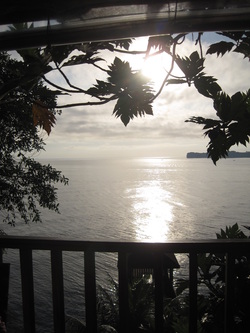
We spent that night in Livingston. A little isolated community that can only be reached by boat. It was a nice relaxing day and I was able to take many lovely photos, and even watch two iguanas duke it out in the tree next to the hotel. All in all, beautiful and worth the time to take a day to relax.
After Livingston we headed up Rio Dulce for a little "hotel" called Finca Tatin. There, my inner hippy was quite content. Tatin is kind of like an eco resort(ish), they run on solar power in the evening and there is any number of eco-adventures to take part in. The entire study abroad group decided to go kayaking through a biotope. Yet another sign that I'm a lake girl, kayaking was definitely a highlight. Somewhat less enjoyable was paddling passed a log sticking out of the river and realizing only after the fact that there was a tarantula only four or five inches from my face. EEK! Luckily it didn't move, and I held it together enough to not scream... The rest of the time in the kayaks was a pure delight, and has me making plans to go canoeing in the Northland of Wisco as much as possible this summer. You can take the girl away from the lake, but you can't take the lake away from the girl, apparently.
From Finca Tatin we headed up Rio Dulce on our way to Tikal.
After Livingston we headed up Rio Dulce for a little "hotel" called Finca Tatin. There, my inner hippy was quite content. Tatin is kind of like an eco resort(ish), they run on solar power in the evening and there is any number of eco-adventures to take part in. The entire study abroad group decided to go kayaking through a biotope. Yet another sign that I'm a lake girl, kayaking was definitely a highlight. Somewhat less enjoyable was paddling passed a log sticking out of the river and realizing only after the fact that there was a tarantula only four or five inches from my face. EEK! Luckily it didn't move, and I held it together enough to not scream... The rest of the time in the kayaks was a pure delight, and has me making plans to go canoeing in the Northland of Wisco as much as possible this summer. You can take the girl away from the lake, but you can't take the lake away from the girl, apparently.
From Finca Tatin we headed up Rio Dulce on our way to Tikal.
Arguably the most popular, and definitely the largest Mayan ruins in Guatemala. Tikal was once the center of Mayan life as one of the most powerful kingdoms during the Classic Period. Not only did we get excessive amounts of photos of all of the temples and ruins, but we were also able to see a lot of wildlife, including monos (monkeys), pavos (turkeys), and coatis (a type of aardvark). It was a magnificent end to a long trip, I have to say.
Be sure to check out all of the pictures in the photo tab to see some of these adventures in visual format!
Be sure to check out all of the pictures in the photo tab to see some of these adventures in visual format!
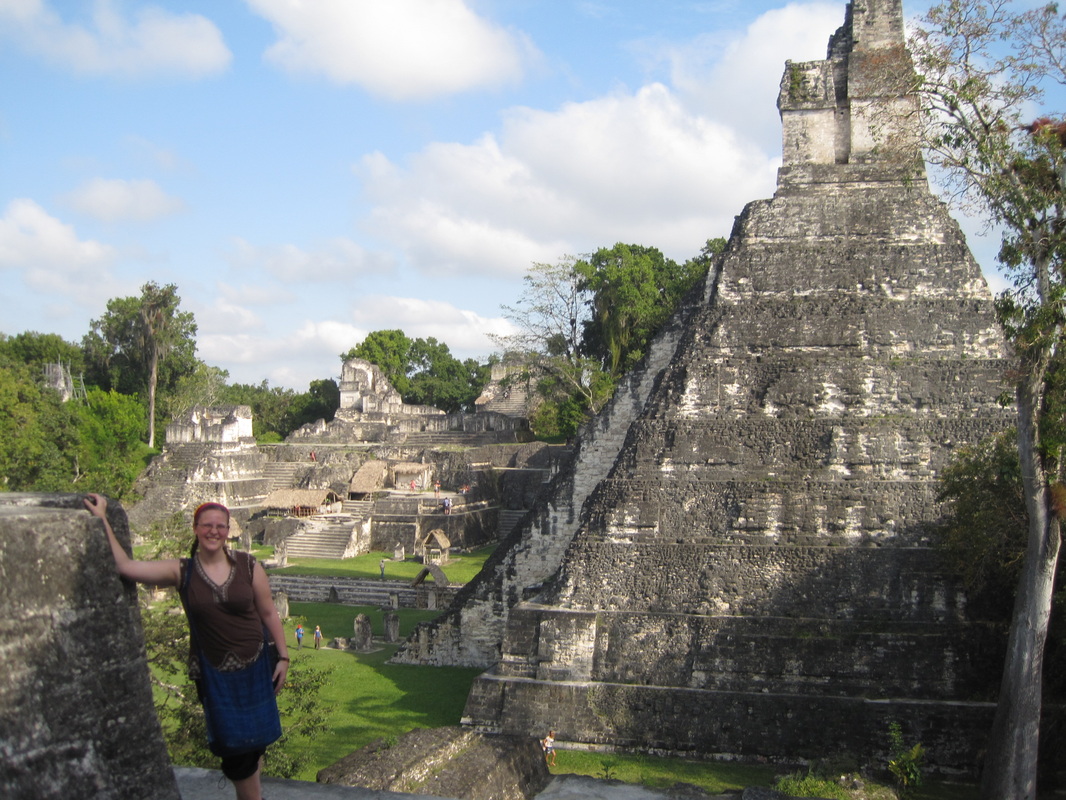

 RSS Feed
RSS Feed